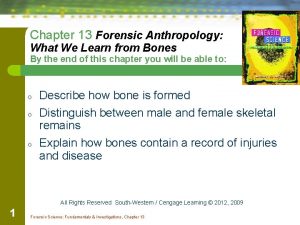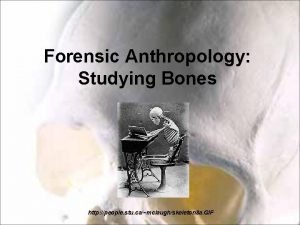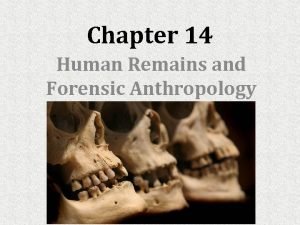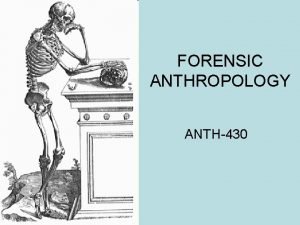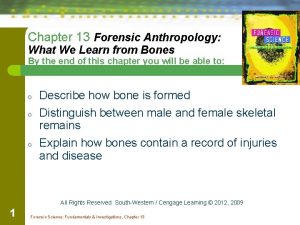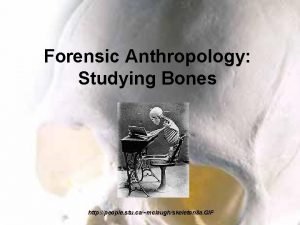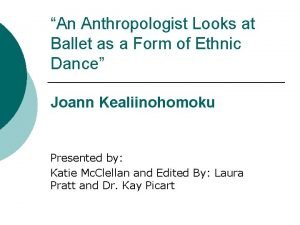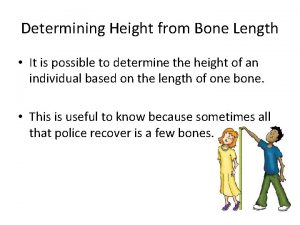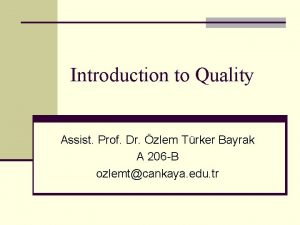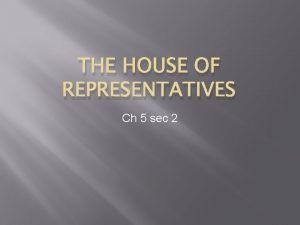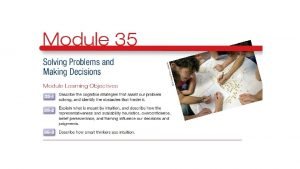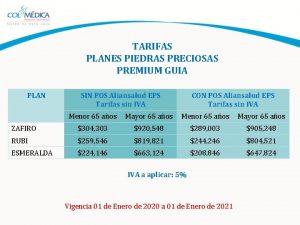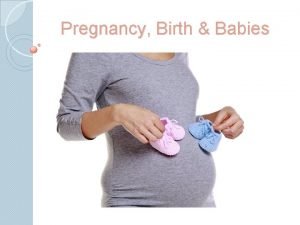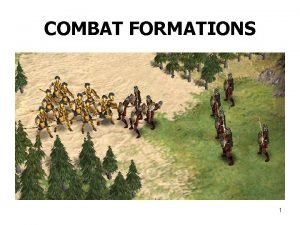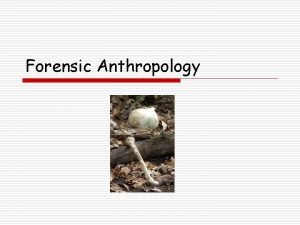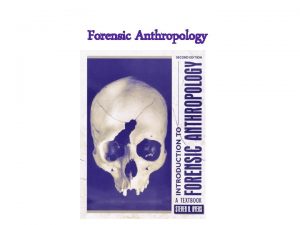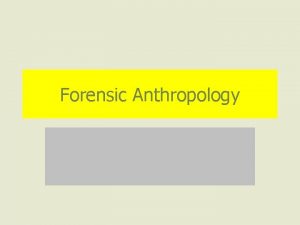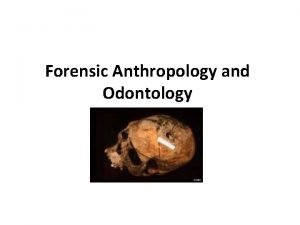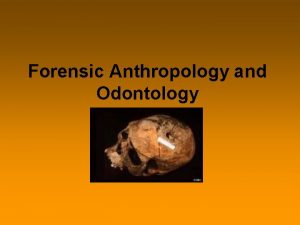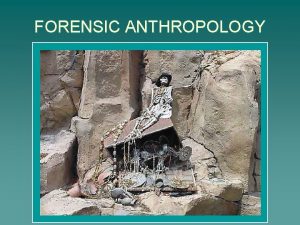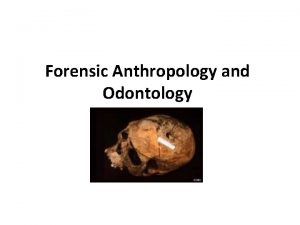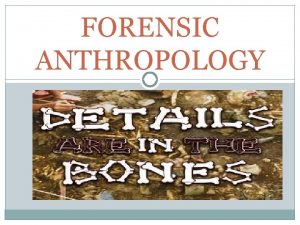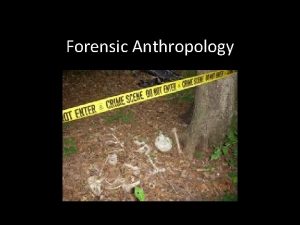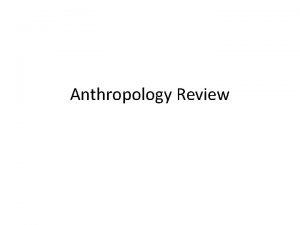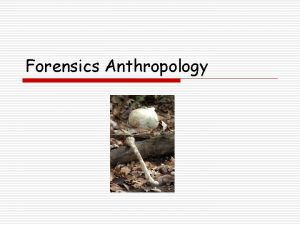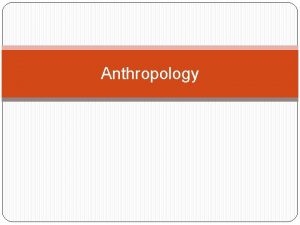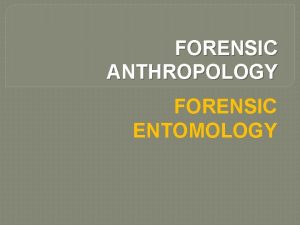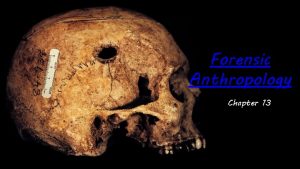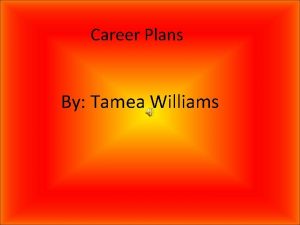Forensic Anthropology A forensic anthropologist can assist in





























- Slides: 29

Forensic Anthropology • A forensic anthropologist can assist in the identification of deceased individuals whose remains are decomposed, burned, mutilated, or otherwise unrecognizable.

Forensic Anthropology • Application of anthropology and human osteology in a legal setting. • Commonly in criminal cases where the victim's remains are in the advanced stages of decomposition.

Applications • The analysis of skeletal, badly decomposed, or otherwise unidentified human remains is important in both legal and humanitarian contexts. • In addition to assisting in locating and recovering human skeletal remains, forensic anthropologists work to assess the following features from a skeleton. – the age, sex, ancestry, stature, and other unique characteristics.

The Bones Know • Bones offer amazing clues to the trained eye. • A trained forensic anthropologist can identify illness, pregnancy, and possible careers of the deceased. • Uses techniques preferred by archaeologists • It is also possible to determine other activities the deceased individual was involved with in life.

The Bones Know • Craniosacral measurements have been established for all ages and race groups – Used for comparative assessments • Unique racial identifiers include – length of jaw – distance between eye sockets.

The Bones Know • Bones also hold clues to the type work a person has done. • Bony ridges form where muscles attach and have pulled over the years. • What might a bony ridge on the wrist indicate about an individual?

DETERMINING GENDER and SEX • Humans are divided into three major subgroups. • Based upon phenotypic characteristics such as cranial and skeletal morphology. • I. CAUCASOID – EUROPE and NORTH AFRICA (Egypt, Libya, Sudan, and Western Sahara), and IRANO-AFGHAN • II. NEGROID – AFRICA (excluding North Africa), Pacific Islands, and Australia • III. MONGOLOID – North America (Native American and Eskimo), South America, Asia (Northern Mongolia, China, Japan, Korea)

Caucasoid SKULLS • European Male Skull • Little or no prognathism exhibited with minimal protrusion of the lower face. • Retreating Zygomatic Bones (cheekbones) make the face look more "pointed". • Narrow nasal aperture with a tear-shaped nasal cavity • European Female Skull

Prognathism • The positional relationship of the mandible and maxilla to the skeletal base where either of the jaws protrudes beyond a predetermined imaginary line in the skull.

Mongoloid SKULLS • Asian Male Skull • Projecting zygomatic bones • Small brow ridge • Small nasal apertures • Asian Female Skull

Negroid SKULLS • African Male Skull • Short skull compared to its width • Receded zygomatic bones • Wide nasal apertures. • African Female Skull

Determination of Age • https: //www. youtube. com/watch? v=c 8 IHPq 9 Vg. WI

Cephalic Index • Cephalic index or Cranial index is the ratio of the maximum width of the head multiplied by 100 divided by its maximum length (horizontal plane, or front to back).

The Pelvic Bone is best for determining the Sex of an Individual • PUBIC ARCH • A female will have a larger subpubic angle to that of a man. – 50 to 60 degrees avg in males – Greater than 80 - 90 degrees in women – Indicative of child bearing requirements • Noticeable differences in all species where child birth is from the womb.

DO NOW NOV 3 • A partial skull has been uncovered by a local landscaping crew. • Cold Case File – Missing 30 y. o. Caucasian female • You have only been able to determine the following…. . • Width of Skull – 19 cm • Length of Skull – 18 cm • Average Cephalic Index of a Caucasian Female is 77 • Is this the woman from the Cold Case?

DO NOW ANSWER • No, this skull is not representative of an adult Caucasian female. • The Cephalic Index of the skull is 106. • What is the likely subgroup this skull belongs to?

DO NOW ANSWER • Negroid Skull • WHY? • A skull belonging to the Caucasoid subgroup has a greater length compared to its width – Equals a smaller Cephalic Index • Negroid skulls are short compared to their length. – Equals a greater Cephalic Index

Learn the bones in RED • (1) sacrum, (2) ilium, (3) ischium, (4) pubis, (5) pubic symphisis, (6) acetabulum, (7) obturator foramen, (8) coccyx

Pelvic Measurements

Determination of Sex • Pelvic inlet is larger in females • Width increases following child birth • It will contract but not back to its original size.

Determination of Sex • Sciatic Notch • In females – wide and circular • In males – narrow and oval shaped

Determination of Sex • Acetabulum - the socket in the pelvis • secures the head of the femur • In females – Greater Acetabular depth with a smaller femoral head. • WHY?

Determination of Age • Pubic Symphysis is the area where the left and right pubis meet. • In females, – This area is bumpy through the teen years – Smoothed out in 20 -30 year olds – Erodes and becomes spongy/porous in women over age 40.

Determination of Age • Bone Caps – unfused in younger individuals – Allows for lengthening of bones – Caps will fuse upon full development • Time frame varies depending on the bone – Clavicle is last bone to fuse at 28 to 30 years

Skeletal Comparisons • Head of Humerus • Males: Greater than 47 mm • Females: Less than 43 mm • Ashes of a Male: 7. 6 lbs • Ashes of a Female: 6. 1 lbs

Male Skulls • European Asian African

Female Skulls • European Asian African


Crossbones Girl Forensic Anthropology • https: //www. youtube. com/watch? v=hft. GJb. PX o 2 w
 Thomas mocker and thomas stewart
Thomas mocker and thomas stewart Chapter 13 forensic anthropology
Chapter 13 forensic anthropology Nasal silling guttering
Nasal silling guttering Chapter 14 forensic anthropology
Chapter 14 forensic anthropology Forensic anthropology data bank
Forensic anthropology data bank Forensic anthropology
Forensic anthropology Chapter 13 forensic anthropology
Chapter 13 forensic anthropology Forensic anthropology race determination
Forensic anthropology race determination An anthropologist looks at ballet
An anthropologist looks at ballet An anthropologist looks at ballet
An anthropologist looks at ballet An anthropologist finds a 29-cm humerus
An anthropologist finds a 29-cm humerus Who is this
Who is this Quality assist
Quality assist Mission assist
Mission assist Assist user guide
Assist user guide The whips assist the party leaders by
The whips assist the party leaders by What cognitive strategies assist our problem solving
What cognitive strategies assist our problem solving Hengityspalje
Hengityspalje Intelligent assist device
Intelligent assist device Cisco smart assist
Cisco smart assist Hormonal stimulus
Hormonal stimulus Medi assist escalation matrix
Medi assist escalation matrix Plan zafiro guía premium colmédica
Plan zafiro guía premium colmédica Travel guard modify policy
Travel guard modify policy Cr assist
Cr assist Gx assist side effects
Gx assist side effects One teach, one assist pros and cons
One teach, one assist pros and cons Peer assist
Peer assist Info assist
Info assist Column formation
Column formation

